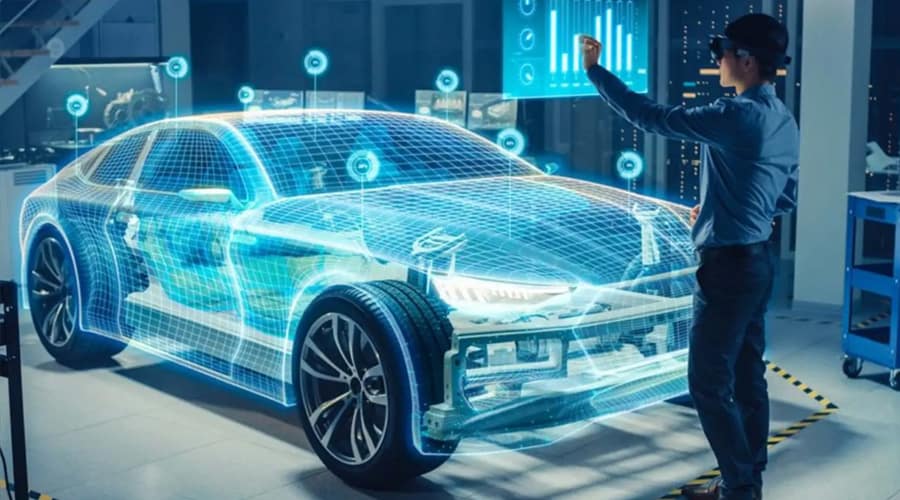Big data and analytics are reshaping the automotive industry in unprecedented ways. The advent of connected cars, IoT, and sophisticated analytics tools has led to a massive amount of data that can be harnessed to revolutionize the industry. The use of analytics is leading to improvements in quality control, inventory management, and supply chain optimization, among other areas. This article aims to examine the impact of analytics on the automotive industry.
Explanation of Big Data and Analytics
Big data refers to a large volume of structured and unstructured data generated by different sources. Analytics, on the other hand, is the process of analyzing this data to uncover insights and make informed decisions. Analytics tools can use machine learning algorithms to identify patterns, relationships, and anomalies in the data. These insights can then be used to make data-driven decisions that can help organizations gain a competitive edge.
A brief overview of the Automotive Industry
The automotive industry is one of the most significant sectors in the world, accounting for millions of jobs and billions of dollars in revenue. The industry encompasses a wide range of activities, including the manufacture of cars, trucks, buses, and other vehicles, as well as the design, engineering, and marketing of automotive products.
Thesis Statement
The increasing use of big data and analytics in the automotive industry is leading to significant changes in the way organizations operate, improving efficiency, and driving innovation.
Big Data in the Automotive Industry
A. Definition and Explanation of Big Data
In the automotive industry, big data refers to the vast amounts of structured and unstructured data generated by various sources, including sensors, connected cars, social media, and customer data.
B. Importance of Big Data in the Automotive Industry
Big data is crucial in the automotive industry because it provides organizations with insights into customer preferences, market trends, and operational performance. By analyzing data from different sources, organizations can make informed decisions that can help them optimize their operations, improve product quality, and enhance the customer experience.
C. Types of Data collected in the Automotive Industry
The automotive industry collects various types of data, including vehicle telemetry data, manufacturing data, customer data, and supply chain data. Vehicle telemetry data refers to the information generated by sensors and other devices embedded in the vehicle. Manufacturing data refers to data collected during the production process, including quality control and testing data. Customer data includes information about customers’ preferences, purchase history, and behavior. Supply chain data includes information about the movement of goods and materials through the supply chain.
D. Sources of Big Data in the Automotive Industry
The sources of big data in the automotive industry include connected cars, social media, customer feedback, and telematics data. Connected cars generate vast amounts of data through sensors and other devices that collect information about the vehicle’s performance, location, and behavior. Social media provides organizations with insights into customer preferences and behavior. Customer feedback provides valuable insights into the customer experience, while telematics data provides information about the vehicle’s usage, performance, and maintenance needs.
Analytics in the Automotive Industry

A. Definition and Explanation of Analytics
Analytics in the automotive industry involves using tools and techniques to analyze data and gain insights into different aspects of the business. Analytics tools can use machine learning algorithms to identify patterns, relationships, and anomalies in the data, enabling organizations to make data-driven decisions.
B. Importance of Analytics in the Automotive Industry
Analytics is crucial in the automotive industry because it helps organizations optimize their operations, improve product quality, and enhance the customer experience. Analytics can help organizations identify inefficiencies in their supply chain, improve manufacturing processes, and optimize inventory management.
C. Types of Analytics used in the Automotive Industry
The automotive industry uses various types of analytics, including descriptive analytics, predictive analytics, and prescriptive analytics. Descriptive analytics involves analyzing
Types of Analytics used in the Automotive Industry

The automotive industry uses various types of analytics to gain insights into different aspects of the business. These include:
- Descriptive analytics: This type of analytics involves analyzing historical data to gain insights into past performance. Descriptive analytics can help organizations understand trends and patterns in their operations, identify areas for improvement, and optimize their processes.
- Predictive analytics: This type of analytics involves using statistical models and machine learning algorithms to predict future outcomes based on historical data. Predictive analytics can help organizations forecast demand, identify potential quality issues, and optimize their supply chain.
- Prescriptive analytics: This type of analytics involves using optimization algorithms to recommend actions that will maximize a particular outcome. Prescriptive analytics can help organizations optimize their production processes, improve inventory management, and enhance the customer experience.
Benefits of Analytics in the Automotive Industry
The use of analytics in the automotive industry offers several benefits, including:
- Improved efficiency: Analytics can help organizations identify inefficiencies in their operations and take corrective action to improve their processes.
- Better decision-making: Analytics provides organizations with insights into their operations, enabling them to make informed decisions that can help them optimize their performance.
- Enhanced customer experience: Analytics can help organizations gain a better understanding of customer preferences and behavior, enabling them to tailor their products and services to meet customer needs.
- Cost savings: Analytics can help organizations identify areas for cost savings, such as reducing waste, optimizing inventory levels, and improving manufacturing efficiency.
Challenges in Implementing Big Data and Analytics in the Automotive Industry
While big data and analytics offer significant benefits to the automotive industry, there are also several challenges that organizations face when implementing these technologies. These include:
- Data Collection and Storage: Collecting and storing large amounts of data can be challenging, especially when dealing with real-time data from connected cars and other sources.
- Data Quality and Accuracy: Ensuring data quality and accuracy can be difficult, especially when dealing with data from multiple sources.
- Data Privacy and Security: Protecting sensitive data from cyber threats and unauthorized access is crucial in the automotive industry, where customer data and intellectual property are at risk.
- Organizational Resistance and Adoption: Implementing big data and analytics can be challenging, especially when there is resistance from employees who are not familiar with these technologies.
Use Cases of Analytics in the Automotive Industry
A. Predictive Maintenance and Quality Control
Analytics can help organizations predict when maintenance is needed on vehicles, reducing downtime and maintenance costs. By analyzing data from sensors and other sources, organizations can identify potential quality issues and take corrective action before they become problems.
B. Inventory Management and Supply Chain Optimization
Analytics can help organizations optimize their inventory levels, reducing the risk of stockouts and excess inventory. By analyzing data from the supply chain, organizations can identify inefficiencies and take corrective action to improve their operations.
C. Sales and Marketing Analytics
Analytics can help organizations gain insights into customer preferences and behavior, enabling them to tailor their marketing and sales efforts to meet customer needs. By analyzing data from social media and other sources, organizations can identify trends and patterns in customer behavior, enabling them to develop more effective marketing campaigns.
D. Autonomous Vehicle Development and Safety
Analytics can play a crucial role in the development of autonomous vehicles, enabling organizations to test and optimize their systems. By analyzing data from sensors and other sources, organizations can identify potential safety issues and take corrective action before they become problems.
Future of Analytics in the Automotive Industry
A. Advancements in Artificial Intelligence and Machine Learning
Advancements in artificial intelligence and machine learning are likely to drive further innovation in the automotive industry, enabling organizations to gain deeper insights into their operations and develop more sophisticated predictive and prescriptive analytics models.
B. Integration of Connected Cars and IoT
The integration of connected cars and the Internet of Things (IoT) is expected to create new opportunities for analytics in the automotive industry. By collecting real-time data from connected cars, organizations can gain insights into driver behavior, vehicle performance, and road conditions, enabling them to optimize their operations and enhance the customer experience.
C. Autonomous Vehicles and Smart Cities
The development of autonomous vehicles and smart cities is also expected to drive further innovation in the automotive industry. By integrating real-time data from autonomous vehicles and other sources, organizations can optimize traffic flow, reduce congestion, and improve safety on the roads.
Conclusion
In conclusion, big data and analytics are reshaping the automotive industry in significant ways. The use of analytics in the industry offers several benefits, including improved efficiency, better decision-making, enhanced customer experience, and cost savings. However, organizations must also address challenges such as data collection and storage, data quality and accuracy, data privacy and security, and organizational resistance and adoption.
As the automotive industry continues to evolve, the future of analytics is likely to involve advancements in artificial intelligence and machine learning, the integration of connected cars and IoT, and the development of autonomous vehicles and smart cities. Organizations that can effectively leverage these technologies will be well-positioned to succeed in the rapidly changing automotive landscape.
The post Big Data, Big Changes: How Analytics is Reshaping the Automotive Industry appeared first on Datafloq.

